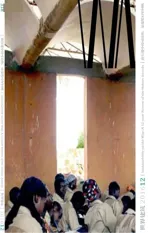物尽其用
2016-12-21黄华青
物尽其用
Using What Already Exists
麦德林位于一片山谷之中。它的水库位于环绕城市的山丘顶端。这个项目展现了废弃水库如何以其他方式再次服务于人民。
哥伦比亚在过去10年间书写着自己经济腾飞的故事。矛盾的是,这个曾经的问题少年正在成为一个突出的优等生:她就是麦德林——哥伦比亚第二大城市。它的年经济增长率达10%,远超全国平均水平4%。2013年3月,花旗银行和华尔街日报将麦德林评为“世界创新之都”——排在纽约和特拉维夫之前。大量国际企业纷至沓来,建造基础设施并提供技术性工作:例如,豪瑞就在麦德林建立了一个共享服务中心,支持运营公司在拉丁美洲的所有事务。然而就在20年之前,绝没有人愿意主动去麦德林。这座城市在1993年之前一直处在大毒枭帕布罗·艾思科巴的暴力统治深渊之中。艾思科巴被击毙后,城市经历了一段更为严重的暴力增长:卡特尔领导者与艾思科巴的继承人相互斗争,麦德林的谋杀率是全球最高的。
2002年,一切开始改变,这主要归功于充满活力的草根政治参与。城市规划官员将精力聚集在潜在获益最大的地区,也就是城市里最穷的街区,那里犯罪率最高,民众急切需要其改变,并显示出强烈的支持政府的意愿。这些地区绵延于环绕麦德林的山上。大体规则是:住的地方离谷底越远,你就越穷。
这些街区,过去大部分都是由鳞次栉比的两层住宅组成,如今这些住宅被大型公寓建筑所取代,由此而密度上升。空缺的土地上建起了新的幼儿园、学校和公园。城市拓展并改善了街道体系,建造了新的基础设施。自此之后,一幅由外形奢华的缆车将山上最穷的人与山谷连接起来的美好画面,向世界宣告着这座城市的惊人复兴。
城市的蝶变为麦德林赢来盛誉。一个例子就是2008年豪瑞奖拉美区金奖,颁发给曾经极为危险的Comuna 13区的改造项目。不过这座城市并未满足于荣誉而止步不前。政府继续利用每一次机会,续写它的成功故事。
其中一次契机来自UVA 孤儿院的饮用水水库。这是一处典型的水库设施,坐落于一座可以俯瞰城市的山顶,由陡坡上密集的居住区所包围。这两座巨大的水库已经过时,最近被两座新水库所取代。由于拆除老水库十分昂贵,又浪费资源,作为城市规划部门的“麦德林公共事业部”(EPM)组织了一次竞赛,收集将它改造以适应其他功能的想法。参赛者中包括马里奥·卡马戈和路易斯·托姆贝两位年轻建筑师,他们的事务所Colectivo720位于哥伦比亚西部最大城市卡利。
Colectivo720事务所提出的改造设计赢得了这次竞赛,这个方案多元而综合。这片区域包括两个废弃水库和两个新水库,过去都是封闭的,而今后将完全对外开放,成为一个公园,以及举办文化和体育活动的设施——它的用途有着无限可能。地面的步行体系是延续性的,与周边街区紧密相连。
坡地地段的一大部分将会由屋顶覆盖,由此形成两个可用层。屋顶的大洞口将光线引入下一层,并容纳垂直交通。底层经过平整后形成活动区域。两座废弃水库会是露天的。其中一座会改造为圆形露天剧场,这是一个多功能舞台,侧面的台阶也可作为剧场的观众席。第二座水库会重新充满水,建筑师设想它为一处长满水生植物的水花园,还有一道观景平台延伸至水面上。底层的其他区域还包括半室内的聚会空间、开敞的水上游戏绿地,在建筑靠后的部分还有充足的办公空间、一间当地特产商店、一间网吧和一间大讲座室。
上层的可用屋顶会铺设草皮,改造为一个多功能公园。在这里,人们可以观看露天剧场及水池,还能欣赏城市令人窒息的全景。大公园中布满了小型干预措施、可持续性项目和有趣的景点。这是一片极其美好的社会—技术景观,附近还有一座全新的、实用的公共图书馆,以及另一处公园,它们都会由新的步行道相连。
为了缩减造价,建筑师最大限度利用了现有的资源。建筑使用了回收材料以及当地建造技术。建造过程将雇佣当地工人,从而通过简单的培训项目传递知识,建立当地人在项目中的参与感。
建筑师非常关注运营及维护成本。人工照明及相关的耗能被控制到尽量低的水平——因此他们使用了反射性立面面层,并将天光引入底层。同时,在后部区域及晚上仍然需要人工照明;电能是用现场的太阳能光伏系统供给的。
这些开口有利于交叉通风,持续的微风能够驱散热流。绿色屋顶和悬挑屋顶为大片区域提供庇荫,保持舒适的温度。建筑中几乎不需要空调,除了网吧之外,那里的电脑需要更强的冷却系统。当地微环境使建筑师的工作变得简单得多。麦德林被称作“永恒的春天之都”,海拔高度1500m,年平均气温21~22℃,气候均衡而宜人。建筑师的干预措施也包括废弃物管理。一种新研制出的项目有利于玻璃、纸张和硬纸板的回收,这些材料会用在工艺美术活动之中,提升当地人的环境保护意识。此外,绿色垃圾也经过处理制成化肥。
另一个项目是推动水资源的合理利用。我们采用了多种措施,减少场地上的用水,以此提升当地人对节约用水方式的意识。其中包括回收雨水及中水以用于灌溉的简单技术。
这个项目所采用的一系列措施——建筑材料再利用、可再生能源、回收项目、中水利用、与自然结合——使它成为可持续性城市开发的标志项目。因此,它也可作为麦德林正在付诸实践的积极发展的有力呈现。(黄华青 译)
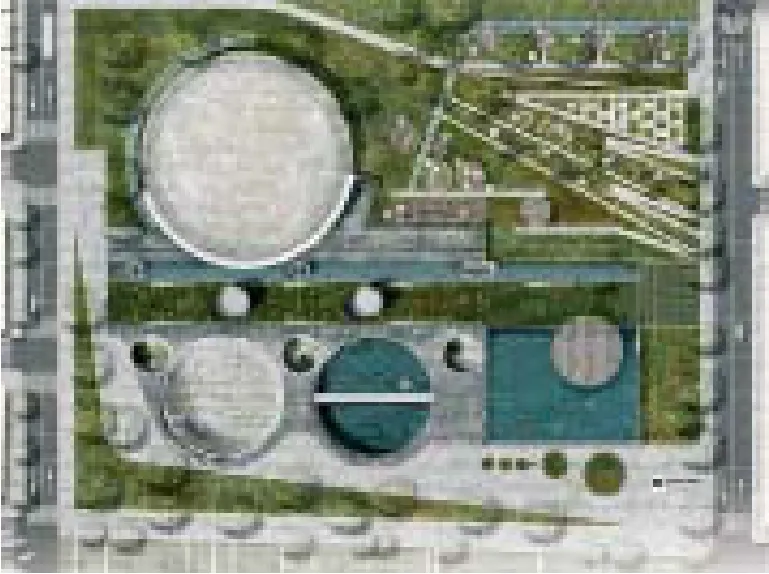
3 总平面/Site plan

4 剖面/Section
Medellín lies in a valley. Its water reservoirs are located atop the surrounding hills. Tis project shows how disused water tanks can be adapted to serve people in other ways.
Colombia has been the author of its own economic success story for the past ten years. Paradoxically, its former problem child is proving to be a particularly celebrated model student: Medellín, the country's second largest city. With an economic growth rate of ten percent annually, this city outstrips the national average of four percent. In March 2013 Citibank and the Wall Street Journal named Medellín "the most innovative city in the world" – ahead of New York and Tel Aviv. International companies are heeding the call of the city in great numbers, building infrastructure and offering skilled jobs; for example, as Holcim has done thereby establishing a shared service center to support all its activities in Latin America. Yet only 20 years ago no one voluntarily went to Medellín. Te city was in the death grip of the powerful drug lord Pablo Escobar until 1993. When Escobar was shot, the city experienced an even greater increase in violence: Cartel leaders fought over the inheritance of Escobar, and Medellín had the highest murder rate in the world.

5 场地三维模型及规划功能/3D model of the site and the proposed intervention

6-8 公共空间/Proposed public spaces
In 2002 things began to turn around, primarily thanks to vigorous grassroots politics. City planning officials concentrated their efforts where the potential gain was greatest: in the poorest neighborhoods of the city, where the crime rate had been the highest, where the people urgently needed change and showed the strongest will to support it. Tese are the areas that have spread up the hills surrounding Medellin. The general rule is: The further from the valley you live, the poorer you are.
Many of these neighborhoods, which previously consisted mainly of two-story houses butted wall to wall, have been densified by replacing the houses with large multi-unit buildings. New kindergartens, schools, and parks were built on the cleared land. The city expanded and improved the street system and created new infrastructure. Since then, pictures of luxurious-looking cable cars, which link the poorest people in the hills to the valley below, have heralded the city's astounding revitalization around the world.
The metamorphosis has earned Medellín great recognition. An example of this is the Holcim Awards Gold 2008 for Latin America, which went to a transformation project in the once highly notorious district Comuna 13. But the city has not rested on its laurels. Te authorities continue to useevery chance to continue the success story.
One such opportunity was offered by the UVA Orfelinato drinking water reservoir. Typical for such facilities, it is situated on a hill overlooking the city, and it is in the middle of a steeply-sloped residential area. The two giant tanks had become out dated and were recently substituted by two new ones. Demolishing the old reservoir tanks would have been very expensive and a waste of resources, so the city planning department"Empresas Públicas de Medellín"(EPM) organized a competition to gather ideas to adapt them for other uses. Te competition participants included Mario Camargo and Luis Tombé, the two young architects who run the firm Colectivo720 in Cali, the largest city in western Colombia.
The intervention that Colectivo720 proposed, and with which they won the city's competition, is diverse and comprehensive. Previously inaccessible, the entire area, including the two disused tanks and the two new ones, will be fully open to the public as a park and venue for cultural events and sports activities – the uses are virtually unlimited. Te site is uninterrupted and linked to the various surrounding neighborhoods.
A large portion of the sloping site will be covered with a roof, thereby creating two usable levels. Large openings in the roof will allow light to reach the lower level and accommodate vertical circulation. Te lower area will be re-graded to make the area level; the two disused water tanks will not be covered. One of them is to be transformed into a round outdoor auditorium, a multi-use arena with steps that double as amphitheater seating. The second tank will be refilled with water. The architects envisage this as an aquatic garden full of water plants and with a viewing pier extending out over the water. Other areas on the lower level include covered gathering spaces and open green spaces where water games can be held, and toward the rear is plenty of space for offices, a shop for local products, an internet cafe, and a large auditorium.
The usable roof deck of the upper level will be carpeted with turf and converted into a multifunctional park. From here you can see the openair auditorium and the pond, and enjoy a breathtaking panorama of the city. Small interventions, sustainable programs, and interesting attractions are spread throughout the large park. Tis is a sociotechnical landscape of exceptional beauty – and very close to a new, well-used public library and another park to which it will be connected by new pedestrian paths.
To minimize construction costs, the architects are using primarily what is already available; Recycled materials and local construction methods will be used for construction. The use of local workers enables knowledge transfer through simple training programs, and builds engagement with the project.
The architects paid particular attention to operation and maintenance costs. The need for artificial lighting and the associated power consumption is being kept as low as possible –which is why they are using reflective surfaces and skylights to bring daylight through the lower level. Still, artificial lighting is required for the rooms in the rear areas and at night; the power is supplied by an on-site photovoltaic system.
Openings allow cross ventilation; the constant breeze dissipates the heat. The green roof and the roof overhang shade large areas to keep temperatures comfortable. Air conditioning is not required except in the internet cafe, where the computers need greater cooling. The local microclimate makes the architects' job easier. Medellín is known as the "capital of eternal spring," thanks to its altitude of 1,500 meters above sea level, and the perfectly-balanced climate with average temperatures of 21 to 22 degrees Celsius. Some of the various interventions on the site involve waste management. A newly developed program facilitates and encourages the collection of glass, paper, and cardboard; the materials are used for arts and crafts projects, increasing the environmental awareness of the population. In addition, green waste is processed and composted.
Another program supports the rational use of water resources. Various methods are applied to reduce water consumption on the site – thus raising people's awareness of possible ways to minimize water use. These include simple technologies for collecting rainwater and graywater used for irrigation.
The variety and number of measures – reuse of building materials, renewable energy sources, recycling programs, graywater use, integration of nature – make this project a symbol of sustainable urban development. And thus also a concrete demonstration of the positive development that Medellín is currently making a reality.
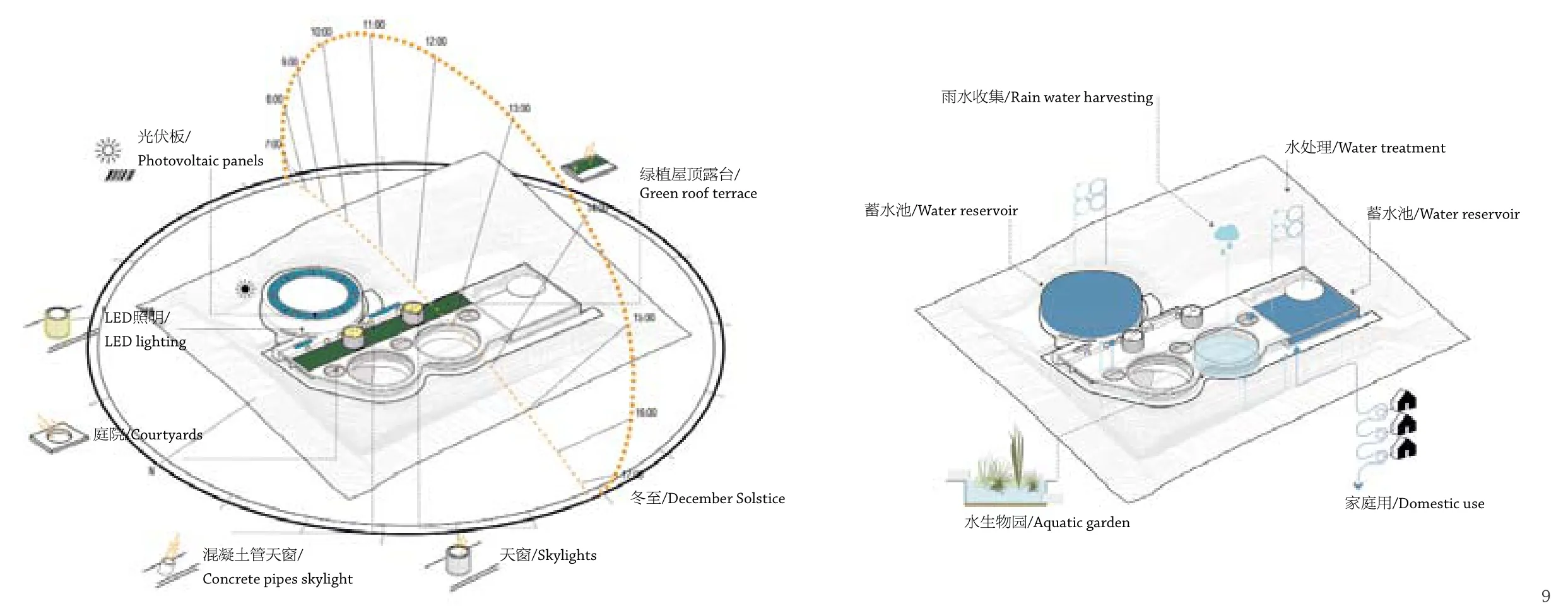
9 人工照明及水处理/Artificial lighting supply and water handling
问:UVA 孤儿院有哪些参赛要求?
马里奥·卡马戈:只有很少的条件。最重要的就是必须让公众受益。
路易斯·托姆贝:有一个初步的任务书。它是通过一个参与性过程建立的,EPM已经提前确定了当地市民的需求和愿望。在今天的麦德林,公众参与到此类项目已经是理所应当的事,我想我们也不能高估这种做法的重要性。
问:你们在设计过程中的目标是什么?
托姆贝:我们从一开始就明确的是,希望能保留地段上积极的特质,创造一个多功能设施——物尽其用。
问:你们将回收材料用在了哪里?
托姆贝:我们所需的一些混凝土,比如在屋顶上,将会用回收混凝土与新的混凝土混合制成,这样能减少混凝土所需的石材骨料。我们还会利用地段上挖掘出的老水管,作为装饰性元素或当作花盆。
卡马戈:我们用回收塑料制作家具。另外还会用废旧车胎制作沙箱及自行车停车架。我们在一切细节中寻求可持续性的解决策略。
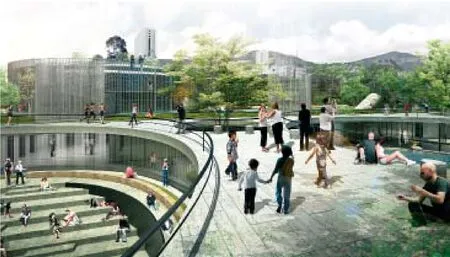
10 屋顶景观/Rooftop view
问:回收材料与整体项目有关吗?还是说只是一个象征性的姿态?
卡马戈:回收利用是我们设计策略中一个重要的可见部分。我们的目标是建造真正可持续性的建筑,因此项目汇总的每一个层面都会最大化地满足这个目标。
问:哥伦比亚对于回收利用的意识有多强?
卡马戈:在全国各地的学校,都开办了使用回收材料的艺术和工艺研修课程。大学也在推动对回收利用的重要性的认识。这种意识无疑是在增长的。
托姆贝:顺便一提,为废弃物建立分离的收集和回收机制,也是由EPM发起而导致的结果。
问:哥伦比亚很快走上了成功的正轨。是什么在驱动这种转变?
卡马戈:我认为这与今天的信息科技有关。我们更容易了解在其他国家发生的事情,可以借鉴新的思想、传递经过验证的理念。用理性的话来说,地域的界限正在消失。
问:信息科技带来的好处全球都适用,然而并不是所有国家都像哥伦比亚这样实现了如此大的飞跃。卡马戈:是的。哥伦比亚取得进步的另一原因,当然是它有很强的政治意愿来改善当下的境况。有时在我看来,这就像是一场裹挟着一切降临的雪崩。改良的意愿如此强烈而积极,人们都为自己的成就而骄傲,没人愿意让已经实现的成果轻易溜走。
托姆贝:学校也对这个发展做出很大的贡献。终究,我们的进步是民主化进程的结果。社会希望看到进步,因此他们也只会为那些能够带来进步的政治家投票。
卡马戈:政府和市民正在合作。你可以看到,我们的项目在帮助将麦德林还给市民。至今为止,这片地段都是禁止入内的;而未来,每个人都可以尽情享受这个公园。
问:在麦德林,我们很惊讶地看到如此大量的绿化空间。这个城市是否还需要更多的公园呢?
托姆贝:这同样是保存现有空间的问题——城市的扩张如此之快,越来越多的废弃区域被重新利用。我们的设计干预或许只是沧海一粟,但它对临近的街区将产生极大的影响。
问:在你们提交竞赛材料时,预计建设会在2014年10月开始。但时间已经过去了,却并没有开始。这是为什么呢?
卡马戈:这很常见,事情推进总是比预想的要花更长时间,不过拖延对项目也有好处:我们研究得更加深入,试图将公园和附近的图书馆密切连接。我们的想法是将社区的室外公共空间更好地整合起来。项目建设开始于2015年4月,并将在2015年年底完工。人们对这个项目的热情很高,在政府内部同样如此。在麦德林不远的未来,还会有更多像这样的水库需要改造。因此,我们这个项目的象征意义——以及获得2014年豪瑞可持续建筑奖拉美区金奖的荣誉——是不可限量的。获奖之后,我们将项目实现的动力更强了。(黄华青 译)
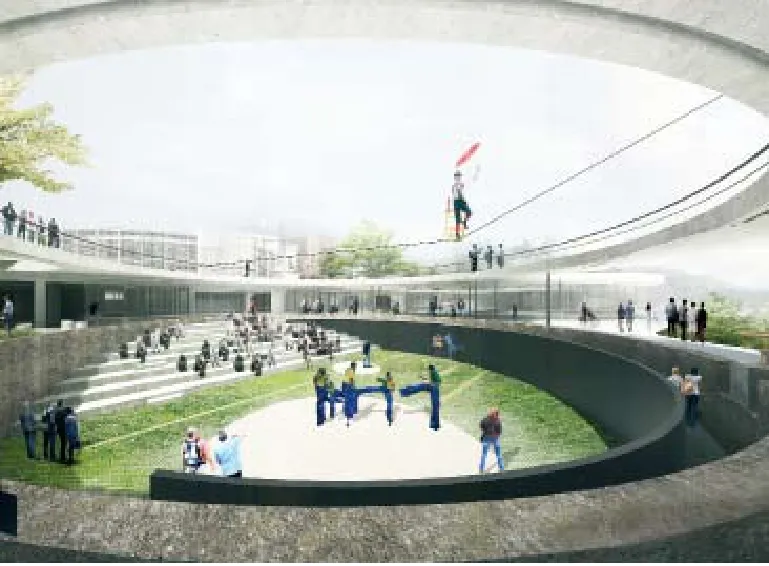
11 室外观礼台/Outdoor auditorium

12 观礼台和日光厅堂/Auditorium and light hall

13 水、日光以及城市景观强调了与场所的认同、提升了该场所的城市地标属性/Water, light and the city landscape accentuate identity with place, and enhance an urban landmark.
Q: What were the requirements of the UVA Orfelinato competition?
Mario Camargo (MC): There were only a few conditions. The most important one was that the solution must benefit the public.
Luis Tombé (LT): And there was a rudimentary room program. Te basis for this was a participatory process by which the EPM had previously clarified the needs and wishes of the local citizens. Te involvement of the people in such projects in Medellín is taken for granted today, and I don't think we can overestimate the importance of this approach.
Q: What were your goals when you developed your project?
LT: For us it was clear from the beginning that we wanted to preserve the site's positive qualities and create a multifunctional facility – using what already exists.
Q: Where are the recycled materials being applied?
LT: Some of the concrete we need, for instance for the roof, will be made from recycled concrete as aggregate in the new concrete, reducing the volume of quarried rock required. We will also use the old water pipes which were excavated from the site; they will serve as decorative features or will be converted into planters.
MC: We are using recycled plastic for the furniture. And we will makes and boxes and bicycle stands from old car tires. We are looking for sustainable solutions across every detail.
Q: Are the recycled materials relevant to the overall project – or are they more of a symbolic gesture?
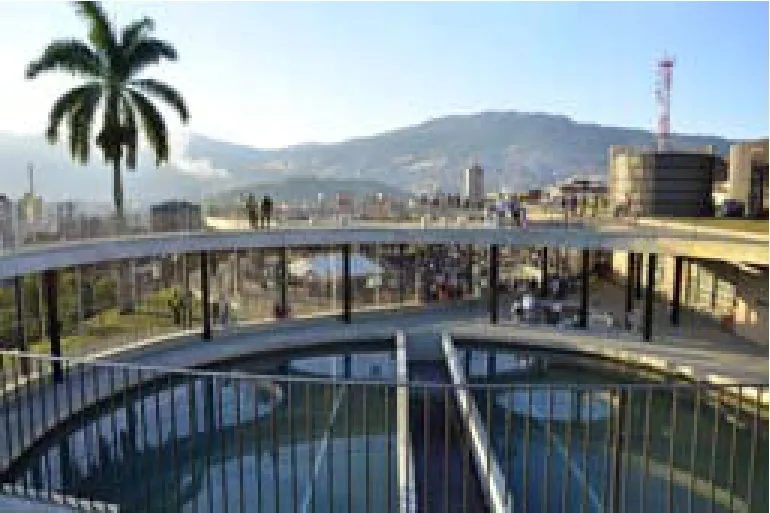
14 长远景象:建筑师将社会性需求与技术性需求融合,以创建“社会—技术化”的景观/Long-term view: the architects merge social imperatives with technical requirements to create a "socio-technical" landscape.(图片来源/Photo: Aníbal Gaviria, Mayor of Medellín)
MC: Recycling is an important and visible part of our strategy. Our aim is to create a genuinely sustainable project; so every aspect of the project is being optimized according to this target.
Q: How strong is the awareness of recycling in Colombia?
MC: At schools around the country there are now workshops in which recycled materials are used in arts and craft classes. Universities are also pushing a new vision of the importance of recycling. Awareness is definitely growing.
LT: Incidentally, getting set up for separate collection and recycling of waste is the result of an EPM initiative.
Q: Colombia found the path to success very quickly. What are the drivers for the transformation?
MC: I think it has a lot to do with today's information technology. We can better take on board what happens in other countries, we can get ideas, and transfer proven concepts. In rational terms, there are fewer and fewer limits.
Q: The benefits of IT apply globally – yet not all countries are making such a leap forward as Colombia. MC: Tat's true. Another reason for the progress being made in Colombia is certainly that there's very strong political will here to improve the situation. Sometimes it all seems to me like an avalanche that carries everything along with it. There's a strong competitive spirit to improve things; people are proud of what they achieve, and no one is willing to let what has been achieved slip away easily.

15 光明未来:建筑形态与现存元素相适应,以确保最小的影响,以获得可承担的可持续性建筑/Bright outlook: The architectural form adapts to the pre-existing elements to ensure minimal impact, and results in an affordable and sustainable building.(图片来源/Photo: Aníbal Gaviria, Mayor of Medellín)
LT: Schools are also significantly contributing to the development. Ultimately, our progress is a consequence of the democratic process. The community wants to see things improved, and they are ready to vote for politicians who will achieve this.
MC: The government and the people are cooperating with each other. You can see that in our project: It's helping to give Medellín back to its citizens. Until now, the site was off limits; but afterwards, everybody will be able to use the park.
Q: In Medellín, one is struck by the large number of green areas. Does the city really need more new parks?
LT: It's also about conserving existing space – the city is growing fast, and more and more rundown areas are being rehabilitated. Even if our intervention is only a small measure, it has great significance for the immediate neighborhood.
Q: Your entry stated that construction would begin October 2014. This date has passed without anything happening. Why?
MC: As often happens, things took a bit longer than we first thought – but the delay benefitted the project: We studied further, and tried to link our park even better with the nearby library. The idea is a more integrated outdoor public place for the community. Construction began in April 2015, and will be completed by the end of the year. There is great enthusiasm for the project, also in the city government. And there are more such reservoirs in Medellín that need to be revamped in the near future. The symbolic power of our project – and the honor to have been recognized with the Holcim Awards Gold 2014 Latin America – is therefore not to be underestimated. Receiving the prize has increased our commitment to materializing the project.
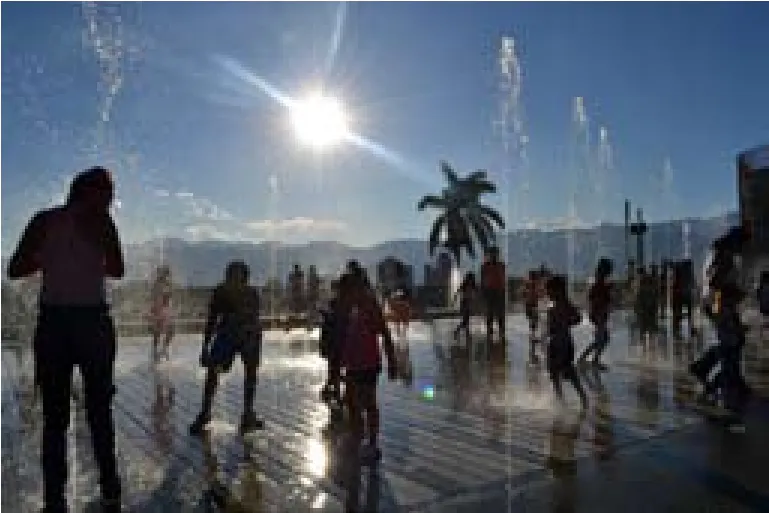
16 建筑师想要保留场所的优势并利用现存条件设计一个多功能的设施/The architects wanted to preserve the site's positive qualities and create a multifunctional facility – using what already existed. (图片来源/Photo: EPM)
